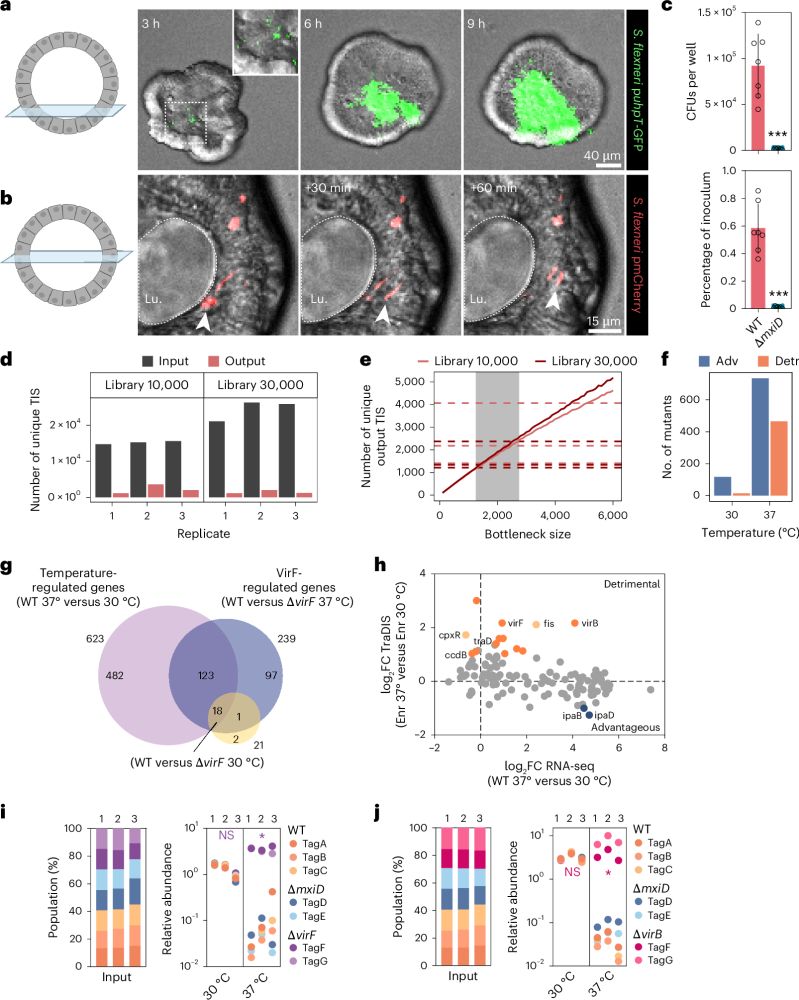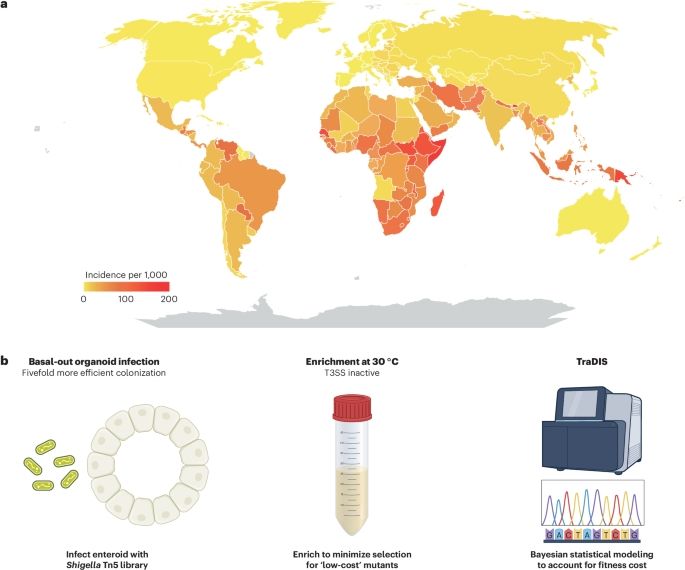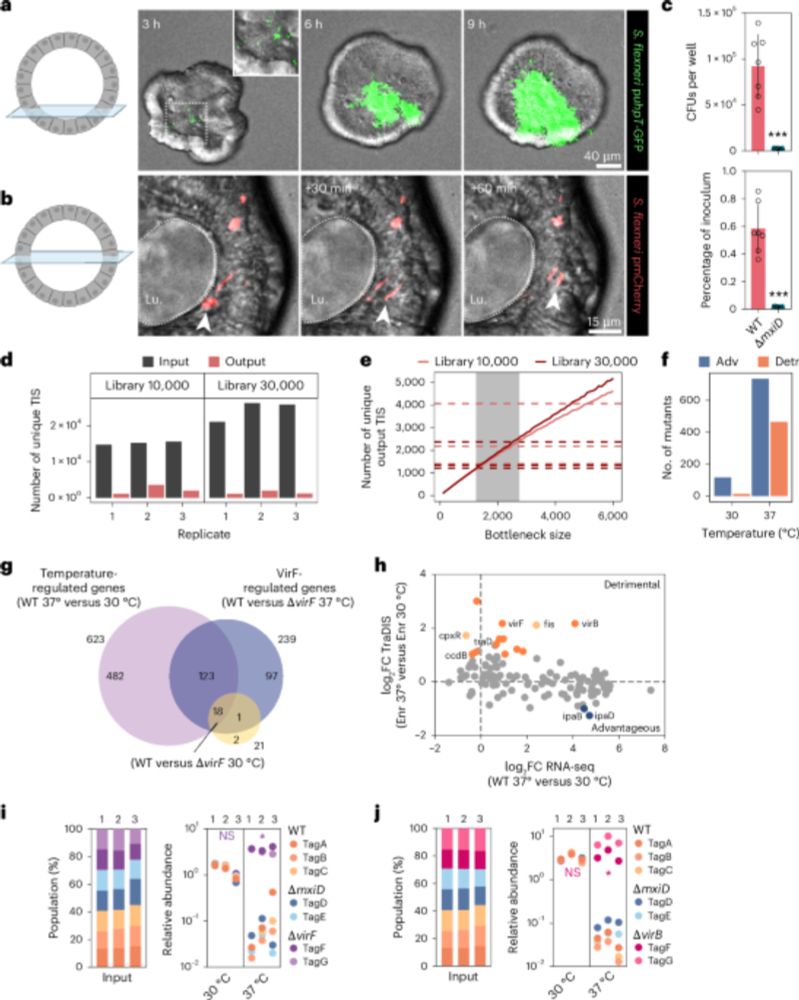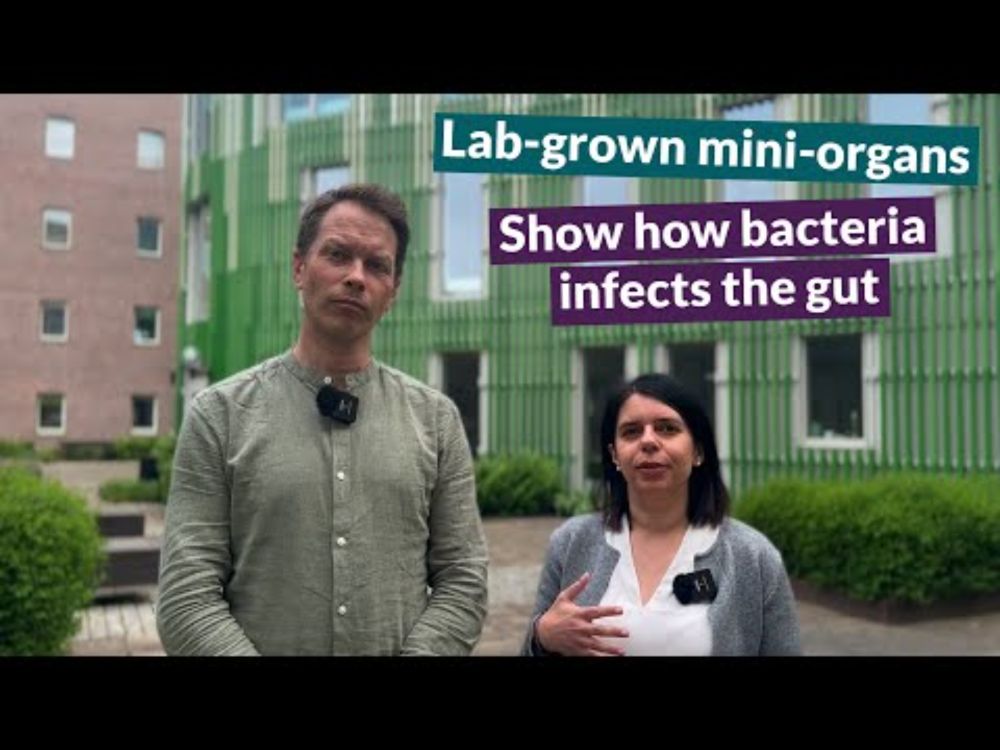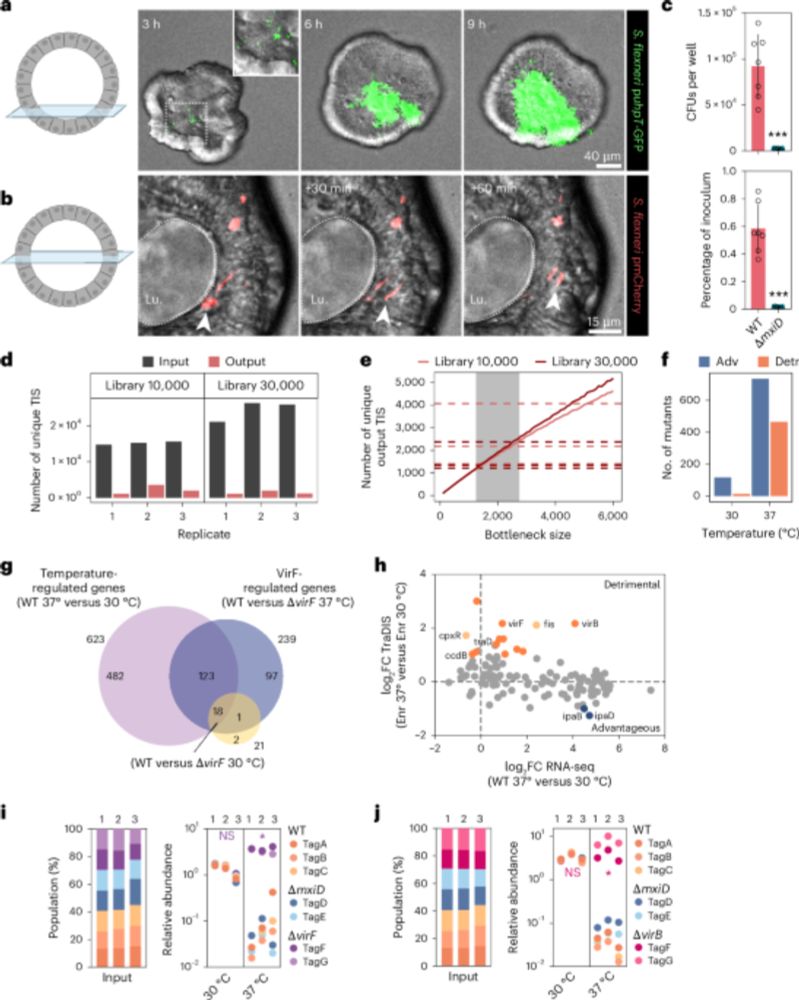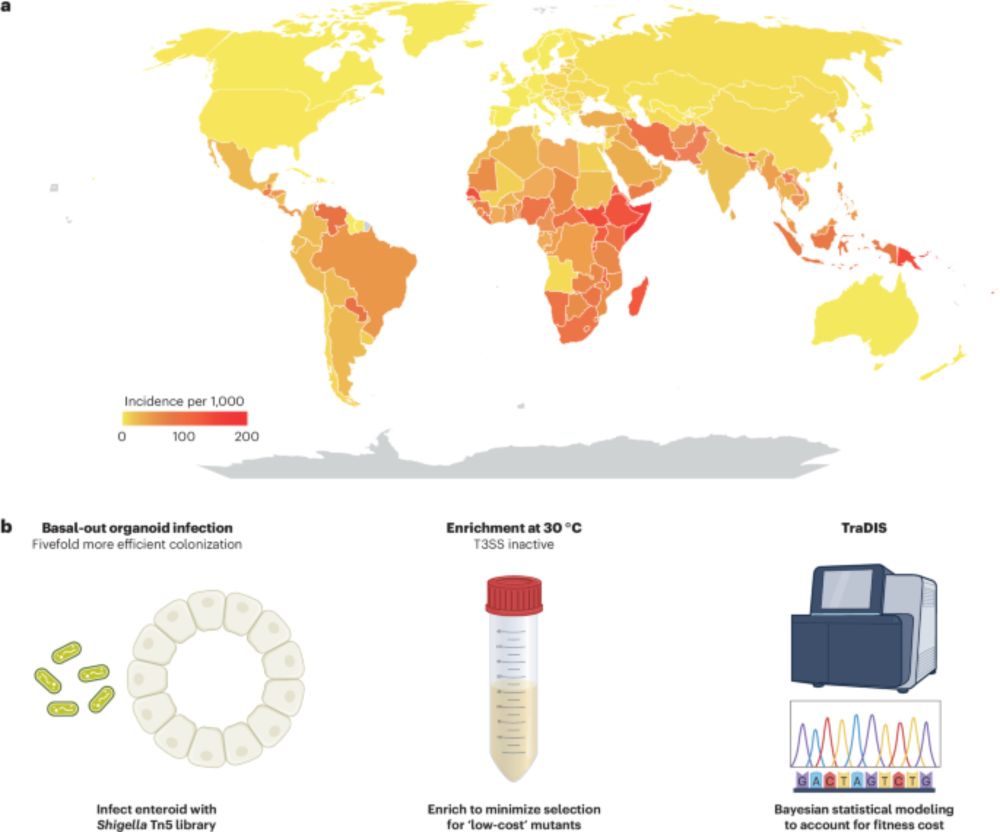Huge thanks to Thibault Frisch, @sellinlab.bsky.social and all other co-authors and collaborators Petra Geiser, Margarita Κomi, Philip Karlsson, Anjeela Bhetwal, Laura Jenniches, @lbarquist.bsky.social , @holmqvist-lab.bsky.social , and @andrenmateus.bsky.social, for making this work possible!
21.11.2025 11:30 — 👍 2 🔁 0 💬 0 📌 0

The pcnB gene sustains Shigella flexneri virulence
Author summary Bacterial infections represent a major global threat. Understanding the genetic determinants promoting infections is crucial to overcome this threat. Shigella is an intracellular bacter...
Thrilled to share that our study on how the pcnB gene sustains Shigella virulence is now published in PLOS Pathogens: journals.plos.org/plospathogen...
In short: pcnB ➝increased virulence-plasmid replication ➝ elevated T3SS expression ➝ enhanced invasion/spread within the intestinal epithelium.
21.11.2025 11:28 — 👍 13 🔁 7 💬 2 📌 0
Happy to announce that our paper is finally out! Thanks to @brozlab.bsky.social and co-authors @elliottbernard.bsky.social @ehartenian.bsky.social 🥳 the NLRP6 inflammasome is activated by sterile- or pathogen-induced endolysosomal damage @embojournal.org
20.11.2025 16:08 — 👍 18 🔁 3 💬 1 📌 0
IT'S HAPPENING! 💥 I'm psyched to launch the collaboration between @qedscience.bsky.social & @openrxiv.bsky.social @biorxivpreprint.bsky.social! Preprint + q.e.d = your science is out there, and anyone can appreciate it. Let's care about making discoveries, and not on “getting published” (1/3) 👇
06.11.2025 14:49 — 👍 128 🔁 64 💬 7 📌 13
Enhanced virulence and stress tolerance are signatures of epidemiologically successful Shigella sonnei
@sydneylmiles.bsky.social @katholt.bsky.social
🙏to transformative collaborative effort
www.nature.com/articles/s41...
13.10.2025 21:48 — 👍 23 🔁 14 💬 1 📌 0

Uridine as a potentiator of aminoglycosides through activation of carbohydrate transporters
Uridine boosts aminoglycoside treatment efficiency against antibiotic-susceptible as well as antibiotic-resistant E. coli strains.
So excited our antibiotic potentiation story is out 🤩 Led by the extraordinary @manonlang.bsky.social with @fox-science.bsky.social & @amazeld.bsky.social +amazing collaborators @immunobladder.bsky.social @imaneelmeouche.bsky.social 🦠 We believe it can make a difference in #AMR infections!
06.09.2025 09:35 — 👍 98 🔁 47 💬 7 📌 4
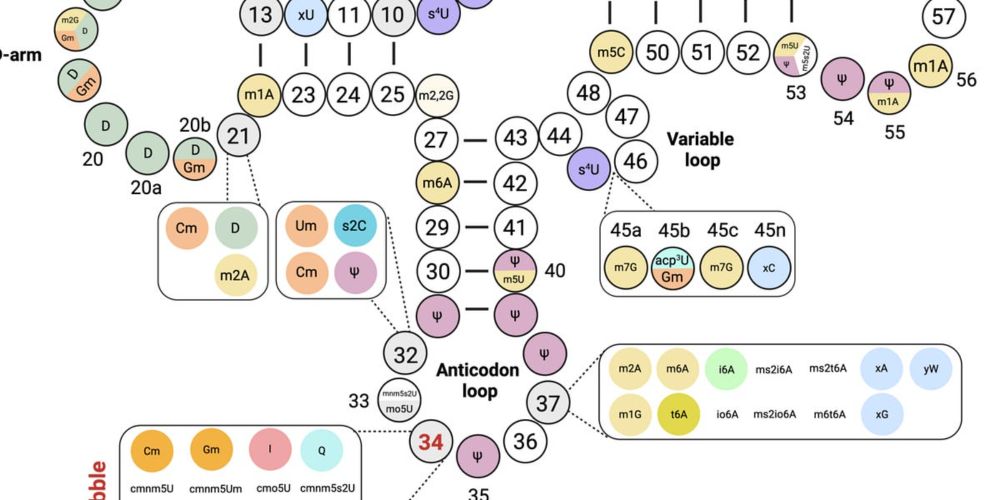
RNA modifications digest Summer 2025
Bimonthly newsletter: RNA modifications and related topics, mostly in bacteria. Summer 2025, first issue!
🦠 Launching a bimonthly digest on RNA modifications and related topics in bacteria!🤩 First issue: Summer 2025. Shared here + by email, future ones will be quicker reads! 😅 #rnasky #microsky #ribosome Subscribe and share if you are interested! rnamodifupdates.substack.com/p/rna-modifi...
15.08.2025 09:30 — 👍 17 🔁 11 💬 0 📌 0

Prof. Lars Barquist. Story title: One the Map: Experimental Research Uses Cultured Mini-Organs to Study Infections
Could lab-grown mini-organs help scientists research a range of infections? A new study published in Nature Genetics shows how researchers have mapped how the Shigella bacterium infects the human gut.
Read our interview with study co-author — and UTM Biology prof — Lars Barquist at uoft.me/bI7.
15.07.2025 18:01 — 👍 6 🔁 4 💬 2 📌 1
Excited to be at #EESMicrobiology this week presenting our latest work on #Shigella gut #organoid infection screen from our recent Nature Genetics paper (see below)!
Stop by poster 109 or just look for me, happy to chat and connect!
#Microbiology #Shigella #Organoids #TraDIS
24.06.2025 08:20 — 👍 9 🔁 2 💬 0 📌 1
The pcnB gene sustains Shigella flexneri virulence https://www.biorxiv.org/content/10.1101/2025.06.16.659909v1
17.06.2025 03:19 — 👍 3 🔁 1 💬 0 📌 0
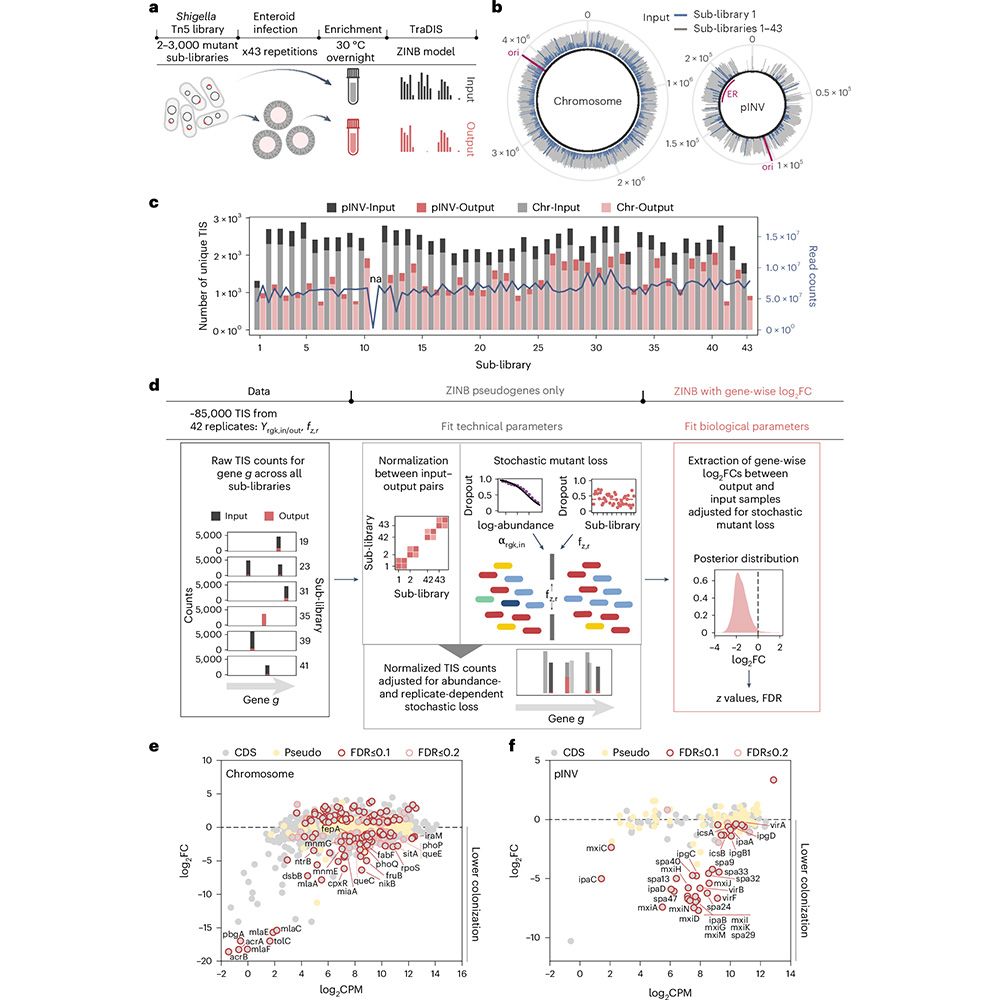
This is figure 2, which shows a genome-wide map of the Shigella geneset required to invade the human enteroid infection model.
A study in Nature Genetics establishes the comprehensive genome-wide map of Shigella genes required to infect human intestinal epithelium. go.nature.com/4e7fdKp 🧬 🧪
17.06.2025 19:24 — 👍 13 🔁 7 💬 1 📌 0
Huge congratulations to Thibault Frisch for leading this work to completion with remarkable insight and drive, and thanks to all co-authors for making it happen! @sellinlab.bsky.social, @lbarquist.bsky.social, @andrenmateus.bsky.social, @holmqvist-lab.bsky.social
17.06.2025 09:39 — 👍 3 🔁 0 💬 0 📌 0
pcnB (poly-A polymerase I) sustains replication of the Shigella virulence plasmid at levels optimal for virulence and boosts intraepithelial expansion in intestinal organoid monolayers.
17.06.2025 09:36 — 👍 0 🔁 0 💬 1 📌 0
New preprint out: www.biorxiv.org/content/10.1...
We followed up on our recent Nature Genetics paper mapping Shigella colonization in intestinal organoids with a deep dive into one of the screen hits: pcnB.
#Shigella #virulence #microsky
17.06.2025 09:35 — 👍 4 🔁 3 💬 1 📌 0
Thank you so much!
13.06.2025 11:35 — 👍 1 🔁 0 💬 0 📌 0
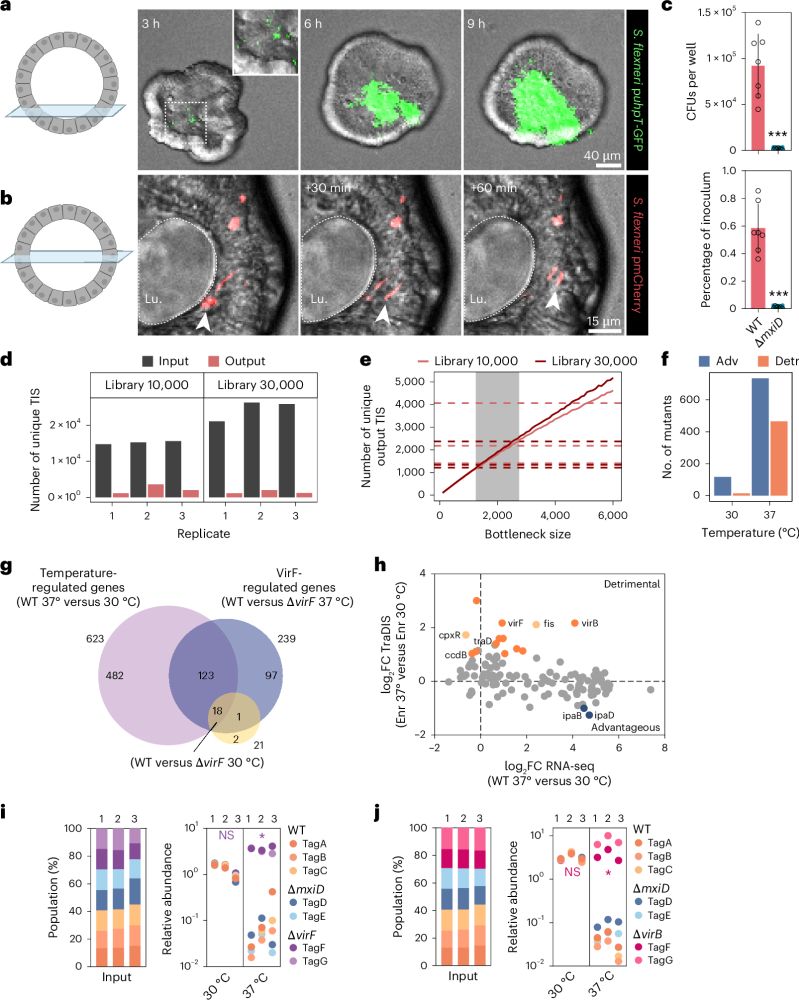
A scalable gut epithelial organoid model reveals the genome-wide colonization landscape of a human-adapted pathogen
Nature Genetics - A genome-wide screen using human gut epithelial organoids combined with transposon-directed insertion sequencing identifies over 100 Shigella flexneri genes required for...
Our latest work combines human gut epithelial #organoid culture with experimental #Shigella #infections, transposon mutagenesis, and statistical modeling. This has led to the mapping of the comprehensive geneset that drives Shigella epithelial colonization.
Out @natgenet.nature.com:
rdcu.be/eqGgf
12.06.2025 14:14 — 👍 32 🔁 20 💬 3 📌 1
Stay tuned for a follow up story coming out soon!
12.06.2025 16:12 — 👍 2 🔁 0 💬 0 📌 0
YouTube video by SciLifeLab
Lab-grown mini-organs help uncover how pathogens cause disease
“we used mini organs, specifically mini-intestines, and infected them with a dangerous bacterium called Shigella” says @mldm.bsky.social
@sellinlab.bsky.social (SciLifeLab & @uu.se) shows that cultured mini-organs can uncover how pathogens cause disease
youtu.be/xG_66ZGd_fk
12.06.2025 09:18 — 👍 3 🔁 2 💬 0 📌 2
Deeply grateful to @sellinlab.bsky.social for the unwavering support! And special thanks to our lab members Anjeela Bhetwal, @erixoneriksson.bsky.social, Ana Lopes, Angelika Ntokaki, and Martina Pasqua for their contributions. Also grateful to @andrenmateus.bsky.social and our clinical collaborators
12.06.2025 15:54 — 👍 2 🔁 0 💬 1 📌 0
This study was co-led with our outstanding collaborators @lbarquist.bsky.social and Laura Jenniches — whose computational expertise was key to making this possible.
12.06.2025 15:53 — 👍 1 🔁 0 💬 1 📌 0
One of the most exciting insights: Shigella uses tRNA-modifying enzymes and codon usage bias to fine-tune its virulence!
12.06.2025 15:52 — 👍 1 🔁 0 💬 1 📌 0
Passionate Microbiologist 🦠🔬 |
PhD @Cambridge_Uni |
ex member Molecular Microbiology (Salmond Lab) at @Cambiochem.bsky.social |
Enthusiastic drummer 🥁 and keyboardist
🎹
Personal web: https://sites.google.com/view/doplaza
Assistant Professor in Aix Marseille Université / Laboratoire de Chimie Bactérienne (LCB) working on bacterial gene regulation
Mom of two ❤️
Early-career researcher in AMR, Mobile Genetic Elements, and One Health & Part-time lecturer.
In love with the intelligence of microbes, their evolutionary designs, and how they outthink every threat.
We are a global voice for bacterial vaccines - uniting scientists, industry and policy-makers. Join us: http://bit.ly/ApplyBactiVac
Hosted @unibirmingham.bsky.social, UK
www.birmingham.ac.uk/bactivac
Bioinformatics, protein modeling, cryoEM, drug screening, function prediction. Daisuke Kihara, professor of Biol/CS, Purdue U. https://kiharalab.org/ YouTube: http://alturl.com/gxvah
Bioinformatics Scientist / Next Generation Sequencing, Single Cell and Spatial Biology, Next Generation Proteomics, Liquid Biopsy, SynBio, Compute Acceleration in biotech // http://albertvilella.substack.com
PhD student at Karolinska Institutet and Scilifelab | Cell physics
https://www.csi-nano.org/
Our group, the Department of Applied Biology at the Karlsruhe Institute of Technology, investigates bacterial secretion systems and virulence mechanisms to better understand their role in infection biology and engineer biotech and healthcare applications
Yersinia Research Unit @pasteur.fr, directed by Javier Pizarro-Cerda. Interested in the life of Yersinia & friend bacteria.
We study gut bacteria and the immune response to infection with a focus on the danger signal extracellular ATP. We particularly like Shigella and E. coli. Located at Queen's University Belfast, UK and Umeå University, Sweden.
Assistant Prof. at Malmö University; modelling of intrinsically disordered regions, membrane-associated proteins, and biomolecular condensates. He/him
PhD student at Cambridge | AMR | genomic surveillance | microbiome
Postdoctoral Researcher / University of Cambridge 👩🏻🔬
PhD candidate (Blaskovich Lab, IMB @ UQ)
Synthetic chemistry & microbiology (let's tackle biofilms!)
Can be found dancing, surfing, & cycling 💃🏼🍊🌻🧪🌊🧬⌬
Working and living on unceded lands
Computational biologist interested in bacterial genomics, bacterial adaptation and antibiotic resistance. @IBV_CSIC
Post-doc at UCL/London Centre for Nanotechnology (https://www.hoogenboom-lab.com/).
Biophysicist 🧪 using atomic force microscopy 🔬 to map outer membrane biogenesis at the single-protein level in living bacteria 🦠
Lecturer in Microbiology | He/Him | Medical Microbiology | Antimicrobial Resistance (AMR) | Genomic Epidemiology | Sexually Transmissible Infections | Bioinformatics | Public Health | Views are my own | Following ≠ endorsing
Public Health #Bioinformatician. Wants to sequence ALL THE THINGS. Personal account with alternative spellings and grammar structures. She/her
Microbiologist :)
Studying bacterial pathogenesis, AMR & antimicrobial development.
Research fellow @ Institute for Molecular Bioscience, UQ
Previously Postdoc @Dunn School of Pathology, University of Oxford.
PhD @The Australian National University
